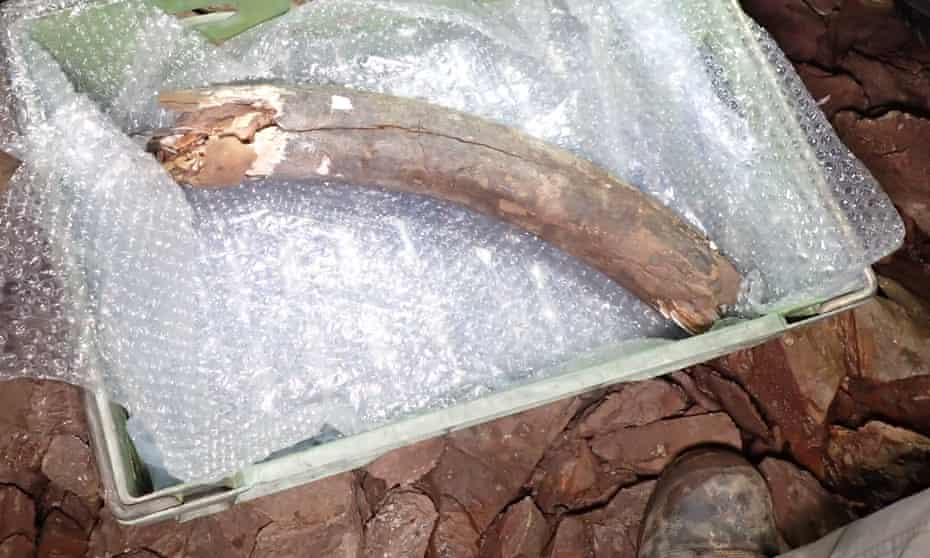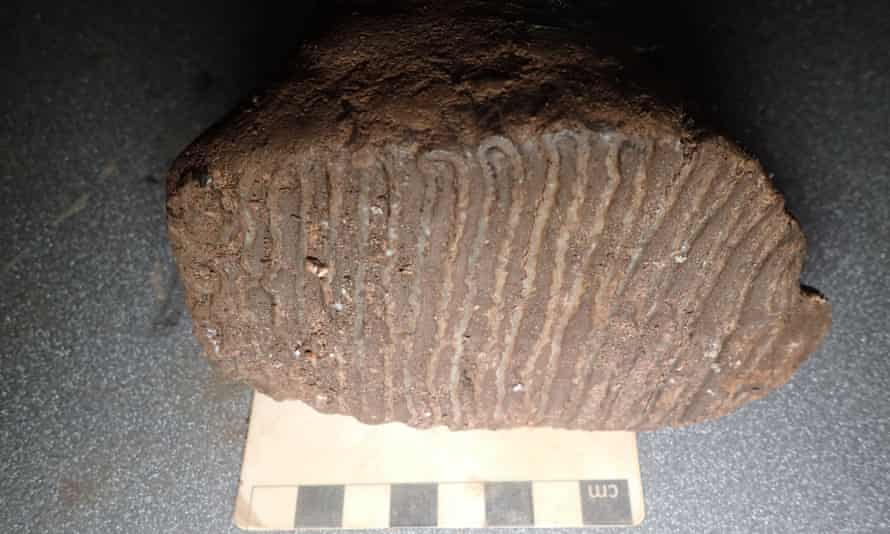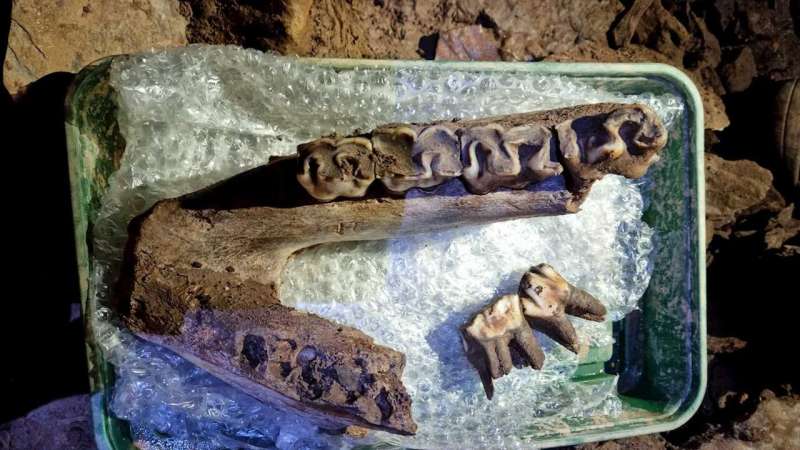Andy Wells
·Freelance Writer
Thu., February 3, 2022
A mammoth tusk is boxed up and sent away to be analysed. (SWNS)
An “exceptional” discovery of the remains of several huge extinct beasts has been described as a “brilliant insight” into life in Ice Age Britain thousands of years ago.
The finds at Sherford, a new town being built in Devon, include a woolly mammoth, rhino and wolf and are estimated to be from the last Ice Age, around 30,000-60,000 years ago in the Middle Devensian period.
They have been described as "rare and nationally significant" and have been painstakingly recovered by a specialist and highly skilled team from across the UK for analysis.
The detailed samples taken from the site have so far uncovered partial remains of a woolly mammoth, including a tusk, molar tooth and other bones and partial remains of a woolly rhinoceros, including an incomplete skull and lower jaw.
There is also a virtually complete wolf skeleton and partial remains of hyena, horse, reindeer, mountain hare and red fox.
An ancient wolf skull was among the finds at the site in Devon. (SWNS)
Woolly rhinoceros remains were found at the site. (SWNS)
Bones of various small mammals such as bats and shrews are also present and it is anticipated that further bones of small mammals will be identified during post-excavation laboratory analysis.
The ‘megafauna’ – large animals now extinct – are hoped to provide new insights into early Britain and enrich what is already known.
Understanding the range of mammals present, particularly herbivores and their food sources, also provides an insight into the plants that may have existed in the local environment, for which little evidence survives today.
Duncan Wilson, chief executive of Historic England, said: "This discovery is exceptional.
The molar of a mammoth is just one of the incredible finds at the site. (SWNS)
Partial remains of a woolly rhinoceros, including an incomplete skull and lower jaw, were discovered. (SWNS)
"To have found partial remains of such a range of species here in Devon gives us a brilliant insight into the animals which roamed around Ice Age Britain thousands of years ago, as well as a better understanding of the environment and climate at the time.
"We are delighted that this important part of our history will be preserved for future generations."
The town of Sherford is is a new 5,500-home community still under development on the edge of Plymouth, and is already home to over 1,500 people.
It was excavation during infrastructure work on site that led to the discovery of the remains.
Samples taken from the site have so far uncovered partial remains of a woolly mammoth, including a tusk, molar tooth and other bones. (Getty/stock picture)
Archaeologists recover ancient woolly rhinoceros remains. (SWNS)
The area where the remains were found will be preserved and no construction will take place on top of it.
Rob Bourn, managing director of Orion Heritage and lead archaeologist on the project for the Sherford Consortium, added: “This is a major discovery of national significance – a once in a lifetime experience for those involved.
"Construction happening at Sherford is the sole reason these findings have been discovered and it is remarkable that they have laid undisturbed until now.
"To find such an array of artefacts untouched for so long is a rare and special occurrence. Equally rare is the presence of complete or semi-complete individual animals.
Parts of a woolly rhinoceros were discovered, including an incomplete skull and lower jaw. (Getty/stock photo)
An archaeologist team member in Devon recording deposits by the wolf skull. (SWNS)
"We look forward to reaching the stage where the discoveries can be shared and displayed, so that everyone can find out more about our distant past.”
Mr Bourn said working theories of how they ended up there included some of the creatures falling into a pit and unable to escape while carnivorous scavengers followed and met a similar fate – or the animals died elsewhere and the bones washed there over a period of time.
It is expected that the full archive of remains will return to Devon, into the care of The Box – a new museum in Plymouth.
Watch: Mammoth tusk holds clues to Ice Age extinctions
Bones of ice age mammoth, bison, rhinoceros, wolf and hyena uncovered by digger on outskirts of Plymouth

Steven Morris
THE GUARDIAN
Thu 3 Feb 2022
The remains of a woolly mammoth, rhinoceros, bison, wolf and hyena have been found in a cave system uncovered by a digger during the building of a new town in the south-west of England.
Experts said the find at Sherford, a 5,500-home development on the outskirts of Plymouth, was “exceptional” and gave an astonishing glimpse into the megafauna that roamed what is now Devon between 30,000 and 60,000 years ago.
More than 200 clusters of bones have been carefully removed from the cave and they will be examined to try to help paint a picture of what life was like in ice age Britain.
The samples taken from the site have so far uncovered:
Partial remains of a woolly mammoth, including a tusk, molar tooth and other bones
Partial remains of a woolly rhinoceros, including an incomplete skull and lower jaw
A virtually complete wolf skeleton
Partial remains of hyena, horse, reindeer, mountain hare and red fox
Bones of various small mammals such as bats and shrews. It is anticipated that further bones of small mammals will be identified during post-excavation laboratory analysis.

Whether all of the creatures uncovered at Sherford coexisted or lived at different points over a much longer time span is uncertain. One theory is that some of the creatures fell into a pit and were unable to escape, and carnivorous scavengers followed and met a similar fate – or the animals died elsewhere and the bones washed into the area over a period of time.
Understanding the range of mammals present, particularly herbivores, will also provide an insight into the plants that may have existed at the time.

Huge ‘sea dragon’ named one of UK’s greatest fossil finds
Danielle Schreve, professor of quaternary science at Royal Holloway University of London, was one of those who crawled into the cave to help supervise the recovery work. “It’s really extraordinary to go into a cave and find remains of things like woolly mammoth tusks,” she said. “It’s pretty special.”
Schreve said it was probably the most significant find of its kind since the discovery of the Joint Mitnor cave in Devon more than 80 years ago.
The animal bones and environmental samples have been recorded and removed from the ground and are undergoing academic analysis and conservation.
It is expected that the full archive of remains will return to Devon, into the care of The Box, Plymouth’s revamped museum. Developers have said the area where the remains were found would be conserved and nothing would be built on top, but the entrance to the cave will be sealed.

Rob Bourn, the managing director of Orion Heritage and lead archaeologist on the project for the Sherford Consortium, said: “This is a major discovery of national significance, a once in a lifetime experience for those involved. To find such an array of artefacts untouched for so long is a rare and special occurrence.”
Bourn said the south-west of England was very different in the time of the mammoth. “It was an area where mammoths and other creatures thrived, roaming great distances across a landscape that looked very different to today, with glaciers not far away in south Wales and a volatile climate prone to huge floods.”
Duncan Wilson, the chief executive of Historic England, said: “This discovery is exceptional. To have found partial remains of such a range of species here in Devon gives us a brilliant insight into the animals which roamed around ice age Britain thousands of years ago, as well as a better understanding of the environment and climate at the time.”
New discovery of ice age fossils in Devon

Fossils of extinct species, including mammoth, rhinoceros and wolf, have been discovered in a Devon cave by a team of archaeologists, including an academic from Royal Holloway, University of London.
Excavations at Sherford, a new town in Plymouth, uncovered the approximate 30-60,000-year-old fossils, belonging to wooly mammoths, wooly rhinoceros, hyena, horse, reindeer, mountain hare and red fox, giving an incredibly rare insight into Britain during the last ice age.
Speaking about the discovery, Professor Danielle Schreve, Head of the Department of Geography and a member of the Centre for Quaternary Research at Royal Holloway, said: "To find a previously unknown cave system is a really special discovery. The fossil bones and teeth not only allow us to reconstruct what conditions were like in the past—a cool, open grassland patrolled by huge herds of grazing animals and across which Neanderthals and then modern humans hunted—but knowledge of how species responded to rapid climate change by shifting their range, evolving or going extinct can help us make better conservation decisions today."
Over recent months, the archaeological team has conducted a detailed analysis of the findings. The work has been led by an expert team including academics from Winchester University and the University of Manchester, Orion Heritage and Exeter-based AC Archaeology, supported by Devon County Council and the South West Science Advisor from Historic England.
Whether all of the fossils uncovered are from a similar time period or existed at different points over a longer time span is under investigation. The remains of megafauna—which are large animals of a geological period that are extinct—as well as a complete skeleton of a wolf, suggest that they probably met an accidental death, falling in through an opening to the ground surface and unable to escape.
It is expected that the full archive of remains will return to Devon, into the care of The Box museum in Plymouth, just a few miles from where they were discovered.
Sherford is a new 5,500-home community under development in Plymouth. The Sherford Consortium—a partnership of Taylor Wimpey and Vistry Partnerships—instigated archaeological work at the start of construction in 2015 and have remained committed to funding an ongoing program of archaeological investigation ever since. Excavation during infrastructure work led to the discovery of these fossils, in an area near Sherford Quarry.New discovery of the earliest known hippo fossil in the UK
Provided by Royal Holloway, University of London
No comments:
Post a Comment